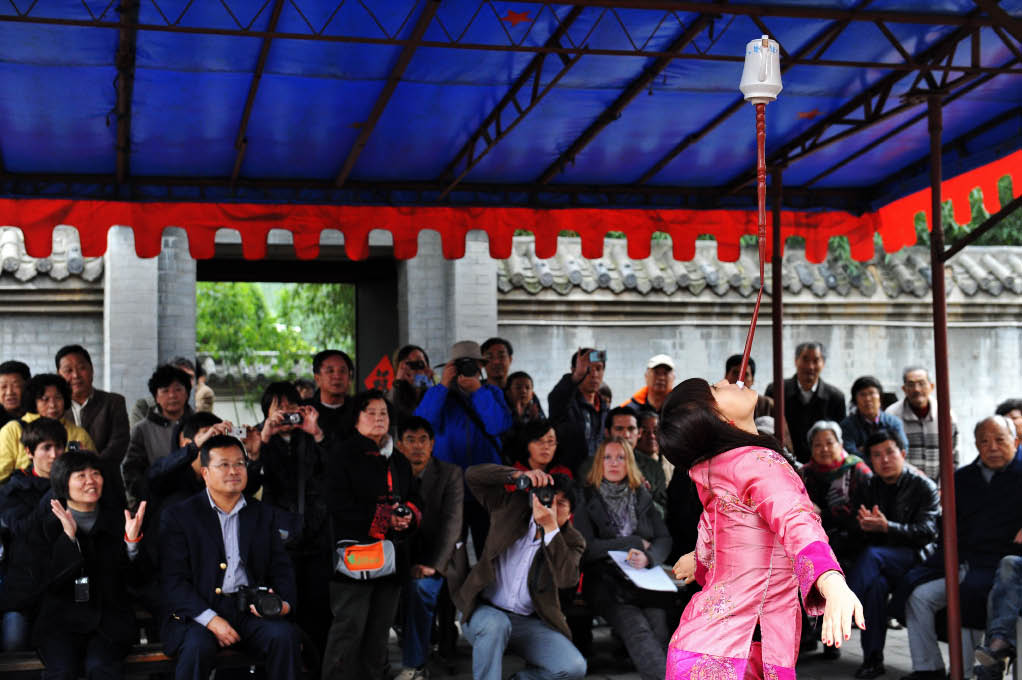Enjoying Acrobatics in an Ancient City
Enjoying Acrobatics in an Ancient City
By staff reporter JIAO FENG

Acrobatics is the family profession of many Wuqiao locals.
AT a distance of 280 km from Beijing, Shijiazhuang, the capital of Hebei Province, is the nearest provincial capital to the seat of the national government.
The region around Shijiazhuang has a long history of developed civilization. Archeological discoveries show that human activities had already begun in this area between 6,000 and 7,000 years ago. It is believed that Fu Xi, who according to ancient legend is among the earliest progenitors of Chinese civilization, once lived here. Shijiazhuang boasts a good number of places of interest, including Xibaipo, Zhaozhou Bridge, the Zhangshiyan scenic spot and many more.
Wuqiao County, 220 km to the east of Shijiazhuang, is one the birthplaces of Chinese acrobatics. Debuting in 1987, the Wuqiao International Acrobatics Festival is an internationally renowned acrobatics festival. As the festival of this kind with the longest history and largest number of participants in China, the Wuqiao festival has become one of the three largest acrobatics competitions in the world. The Gold Lion Prize awarded there has become one of the most coveted by acrobats around the world.
The Wuqiao International Acrobatics Festival is held biennially, generally from late October to early November. Major features of the festival include acrobatic competitions and exhibitions, traditional folk art performances and international circus forums. Circuses from over 40 countries and regions around the world have participated in the festival, and thus it has become known as "the biggest acrobatic event in the east."
The Birthplace of Chinese Circus
The acrobatic arts are very popular among Wuqiao locals. There is a saying: "All people in Wuqiao, from the 99-year-olds to the toddlers, are acrobats." Strolling around town, it's easy to see how much a part acrobatics is of daily life. Children somersault on streets; youngsters balance umbrellas on their noses; farmers practice plate spinning next to their fields, and at wedding banquets the bride and bridegroom distribute sweets and cigarettes to guests using sleights of hand and amazing magic tricks. At present, the county is home to nearly 10,000 acrobatics practitioners and more than 100 troupes.
Acrobatics has a long tradition in Wuqiao. According to the county's annals, local people traditionally liked to dress up in colorful costumes and masks of beasts and perform acrobatic feats at festivals, weddings and birthday celebrations. Every year after the autumn harvest, an acrobatic fair would be held from the mid-eighth to the mid-ninth lunar month. It was an occasion for acrobats, magicians and puppeteers from all over the country to compete and learn from one another, visit masters and peers, and set up circus troupes. At the same time, circus props such as knives and swords, and some animals, such as dogs, monkeys, bears and snakes, would be sold at the fair. When the fair ended, players and troupes continued on with their nomadic lifestyle, roaming China and even abroad in order to earn a living performing stunts.
The Wuqiao people's predisposition to acrobatics could be attributed to the local natural environment. Wuqiao is located in the lower reaches of the Yellow River. The Beijing-Hangzhou Grand Canal flows through the county in the west. Criss-crossing rivers and creeks cover a majority of the county's land area, making it prone to flooding, and the soil itself is infertile, making agriculture unprofitable. Local people therefore had to learn other skills such as acrobatics to forge a living.
Acrobatics in Wuqiao falls into many schools, all with different features. In the mid-Ming Dynasty (1368-1644), two schools had gradually been developed – the East and the West. The West School grew faster, becoming popular all over Wuqiao County and was divided into several branches, including the Lius' martial arts and equestrianism, the Qis' qigong and the Taos' magic and tricks. All branches were traditionally distinctive from one another. As communication and exchanges increased, however, the different branches gradually integrated and became one. In 1917, Wuqiao acrobat Sun Fuyou recruited the best performers belonging to different branches and set up China's first big circus and went on to win renown throughout Southeast Asia.
Traditional Wuqiao acrobatics falls into four categories (martial arts, sideshows, animal training and magic tricks) and 13 types (martial arts, balancing with head, juggling with feet, hand tricks, trick-cycling, horsemanship, tricks high in the air, wire-walking, jumping through the rings, vocal imitation, mouth tricks, magic and others, such as kicking the shuttlecock and juggling diabolos). Apart from handing down cherished techniques from generation to generation of apprentices, Wuqiao acrobats ensure the vitality of this cultural heritage by learning and incorporating other art forms, creating new spectacles such as lion dancing, flag performances, "cage of death" car stunts, double-swinging and many more.
In this year's festival, acrobats introduced the concept of "new acrobatics," which integrated acrobatics into other art forms like dance and music. This came with the application of new technologies so as to bring high-level visual and sound effects to the performances.
Services
Economy
- Eco-agriculture and Eco-tourism Power Nanchang’s Green Development
- Balance Environmental Protection and Economic Prosperity – Nanchang Looks to European Technology for Green Development
- Sustainable Growth Requires Wiser Energy Use
- Chinese Economy: On the Path of Scientific Development
- China's Economy over the Last Ten Years

